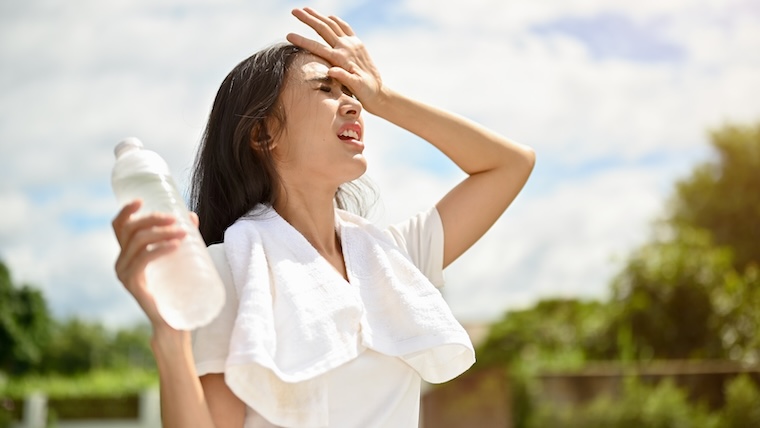While competitive athletes often have no control over the conditions they compete in, failing to acclimate to hot weather properly can have detrimental consequences, including dehydration, cardiovascular strain, dizziness, weakness, nausea, vomiting, and even fainting. (1)
On Aug. 6, 2024, Dr. Gommaar D’Hulst, Ph.D. in Sport Sciences and Biology, explained the body’s physiological responses to heat during exercise and the most effective strategies to acclimate to it before a competition.
[Related: Why You Sweat More as You Get Stronger]
Exercise’s Effects on the Body
Exercise triggers several physiological processes in the body. An individual’s heart rate increases to pump more blood (up to 190-200 beats per minute for some athletes), and cardiac output (the volume of blood pumped per minute) increases from three to four liters at rest to 40 to 60 liters per minute in athletes.
“The goal of the cardiovascular system is to convert chemical energy (food) into mechanical energy (ATP),” D’Hulst explained. As muscles work, they consume energy and produce heat. The body must dissipate this heat to maintain a stable core temperature.
How the Body Copes With Heat
D’Hulst highlights that of the 100 percent of energy produced, only 20 percent is converted into mechanical energy, whereas 80 percent is released as heat. “It is very important for the body to cope with this extra heat,” he adds.
The body eliminates heat through various mechanisms, including:
- Evaporation: Getting rid of heat via sweating.
- Convection: Air movement around the body helps carry heat away.
- Radiation: The body releases heat in the form of electromagnetic waves.
- Conduction: Direct contact with cooler objects allows heat to transfer.
“The most important ways to get rid of heat during exercise are evaporation and convection,” D’Hulst says. Ninety-five percent of the body’s heat dissipation occurs through evaporation, especially during intense exercise in hot conditions.
It is very important to sweat well as an athlete.
[Related: Why Don’t I Sweat When I Work Out?]
Importance of Heat Acclimation for Performance
Heat acclimation involves gradually exposing the body to hot weather conditions. This helps the body adapt and better regulate its temperature. Heat acclimation helps athletes sweat more efficiently by increasing their plasma volume (the liquid component of blood) and improving skin blood flow. This allows them to start sweating sooner and more during exercise, enhancing their cooling capacity.

A randomized controlled trial published in the Journal of Applied Physiology examined the effects of heat acclimation on athletes. One group trained in hot conditions (40°C/104°F) for heat acclimation, while a control group exercised in cool conditions (13°C/55.4°F). The results showed that heat acclimation improved VO2 Max (maximum oxygen uptake) and performance in hot and cool conditions. (2)
D’Hulst explains that this positive impact is attributed to increased plasma volume resulting from heat acclimation, which enables greater blood flow to the working muscles.
Practical Recommendations for Heat Acclimation
D’Hulst prescribes longer, moderate-intensity workouts, lasting around 90 minutes, for at least two to three weeks before a competition for optimal heat acclimation. This approach allows the body to gradually adapt to the challenging environment and become more efficient at sweating and dissipating heat.
References
- Institute of Medicine (US) Committee on Military Nutrition Research; Marriott BM, editor. Nutritional Needs in Hot Environments: Applications for Military Personnel in Field Operations. Washington (DC): National Academies Press (US); 1993. 3, Physiological Responses to Exercise in the Heat. Available from: https://www.ncbi.nlm.nih.gov/books/NBK236240/
- Lorenzo, S., Halliwill, J. R., Sawka, M. N., & Minson, C. T. (2010). Heat acclimation improves exercise performance. Journal of Applied Physiology (Bethesda, Md.: 1985), 109(4), 1140–1147. https://doi.org/10.1152/japplphysiol.00495.2010
Featured image via Shutterstock/BongkarnGraphic